Physical Risk Indicators Associated with the Amount of Water:
The risks of natural water systems and those associated with water resources are part of what is known as ecological risk, which is defined as the potential damages and losses that can occur in ecosystems and their services, due to hazardous physical events of l natural, socio-natural, technological, biosanitary or unintentional human origin, in a specific period of time, determined by the vulnerability of the exposed ecosystems.
Risk is the product of the change in threat based on the state of vulnerability, which is the relationship between sensitivity and adaptive capacity. For this, the following should be considered when analyzing threats to the water system:
- Decrease in natural water supply as a consequence of climate variability and change.
- Decrease in the capacity of water systems to retain and regulate flows given the loss of regulating ecosystems (paramos, wetlands) as a result of fires, mass movements and erosion, and by sectoral activities such as mining, agriculture and livestock.
In turn, water resource vulnerability must take into account the following analysis criteria:
- Vulnerability to water availability is associated with the relationship between the physicochemical characteristics of water and the quality conditions required for different uses, such as access to water due to problems in water catchment.
- Vulnerability to water shortages is associated with the relationship between the variability of the available supply of the resource and its demand for human activities.
- Vulnerability to water availability is associated with the relationship between the physicochemical characteristics of the water and the quality conditions required for the different uses, such as access to water due to problems in catchment problems.
It is recommended to consider the indicators proposed by Aqueduct, a database created by the World Resource Institute in response to growing concerns from the private sector and other stakeholders about water availability, water quality, climate change and growing demand. WaterProof makes use of Aqueduct data as well as indicators, including:
Benchmark water stress indicator establishes the relationship between freshwater withdrawal in proportion to available freshwater resources. It analyzes the total fresh water extracted by the main economic sectors and the total renewable water resources, taking into account environmental water needs. For the estimation, consumptive and non-consumptive domestic, industrial, agricultural and livestock uses are taken into account. Available renewable water supplies include the impact of upstream drinking water users and large dams on downstream water availability. High values in this indicator express greater competition among users. This indicator is estimated on a monthly and annual level.
The categorization for the level of risk that this indicator has is shown below:
Table 1. Level of risk Reference water stress
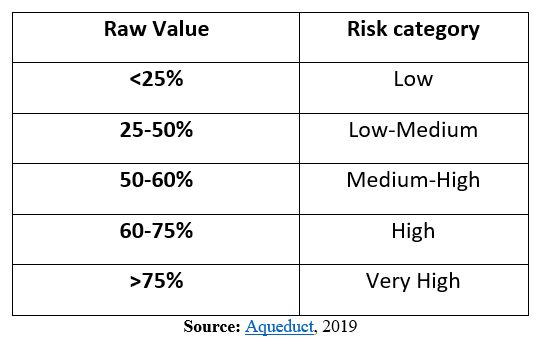
Baseline water depletion indicator measures the proportion of total water consumed from available renewable water supplies, where total water consumption includes domestic, industrial, irrigation and livestock consumptive uses. It analyzes the impact of water availability from upstream users and large river dams. Higher values of the indicator explain larger impacts on local water supply and decreased water availability for downstream users. This indicator is estimated on a monthly and annual basis. The categorization for the risk level of this indicator is shown below:
Table 2. Level of risk Reference water depletion
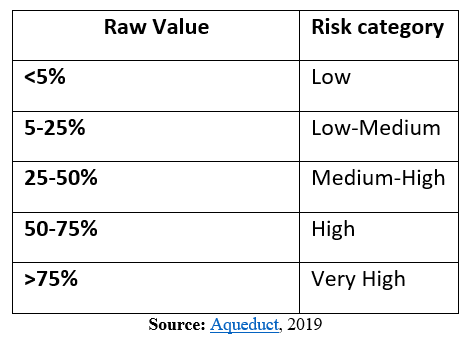
Interannual variability indicator: It refers to the variation in water supply between years, it varies from 0-5, where 0 is the lowest and 5 is the highest. It is obtained by analyzing the time series in which it is possible to detect, over the years, significant fluctuations, above or below normal in the behavior of the dry or rainy seasons. This indicator is estimated on a monthly and annual level. The categorization for the level of risk that this indicator has is shown below:
Table 3. Risk level Interannual variabilityRaw
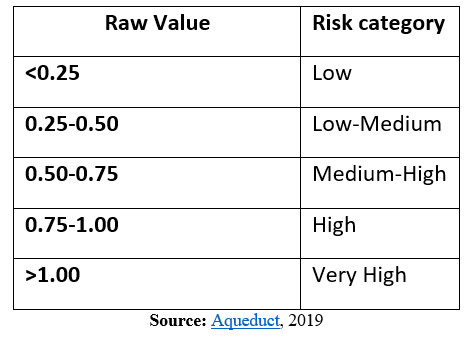
Interannual variability indicator: Refers to the variation in water supply between years, ranging from 0-5, where 0 is the lowest and 5 the highest. It is obtained through the analysis of time series in which it is possible to detect, through the years, important fluctuations, above or below normal in the behavior of dry or rainy seasons. This indicator is estimated on a monthly and annual basis. The categorization for the risk level of this indicator is shown below:
Table 5. Level of risk Decrease in the water table
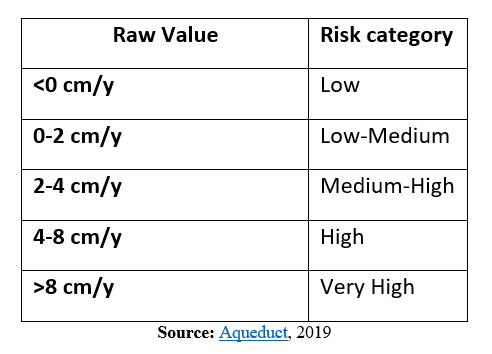
Fluvial flood risk indicator analyzes the water flows that exceed the natural or artificial banks of a stream, and occupy a portion of the land that form plains in the river valleys due to excess flows are natural processes that have occurred over time. They represent the relationship between the probability of a threat occurring and the number of victims it produces in a given study area.
Flood risk is assessed using hazard (flood caused by river overflow), exposure (population in the flood zone) and vulnerability. The existing level of flood protection is also incorporated into the risk calculation. It is important to note that this indicator represents the flood risk not in terms of the maximum possible impact but rather as the average annual impact. The impacts of infrequent and extreme flood years are averaged with more common and less newsworthy flood years to produce the "expected annual affected population." High values in this indicator express that a greater proportion of the population is expected to be affected by river flooding on average.
This indicator is estimated on an annual basis. The categorization for the level of risk that this indicator has is shown below:
Table 6. Risk level River flooding
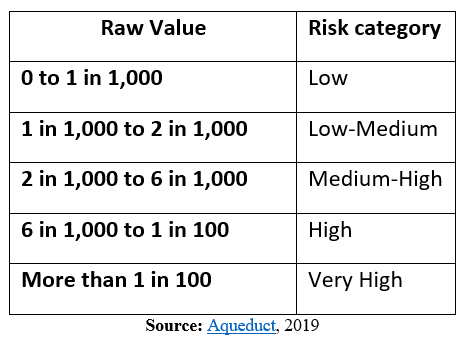
Drought Risk Indicator: The Drought Risk Index (DRI), also known as the Normalized Precipitation Indicator (NPI), is based on the probability of rain, in any period of time. It was developed by McKee et al. (1993) to quantify the rainfall deficit over multiple time periods. A drought occurs as long as the IRS is permanently negative and reaches an intensity of -1.0, or less. This indicator is estimated on an annual basis. The categorization for the level of risk that this indicator has is shown below:
Table 8. Risk level Drought
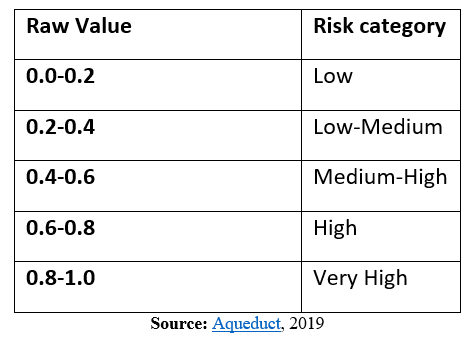
Bibliography
Progresos en el nivel de estrés hídrico. Valores de referencia mundiales para el indicador 6.4.2 de los ODS. 2018. FAO. | http://www.unwater.org/app/uploads/2018/12/SDG6_Indicator_Report_642_Progress-on-Level-of-Water-Stress_2018_SPANISH.pdf.pdf
Indicador 6.4.2 - Nivel de estrés hídrico: extracción de agua dulce en proporción a los recursos de agua dulce disponibles. 2021. FAO. | http://www.fao.org/sustainable-development-goals/indicators/642/es/
Referencies
Monitoreo del agua y el saneamiento en la Agenda 2030 para el Desarrollo Sostenible | https://www.sdg6monitoring.org/